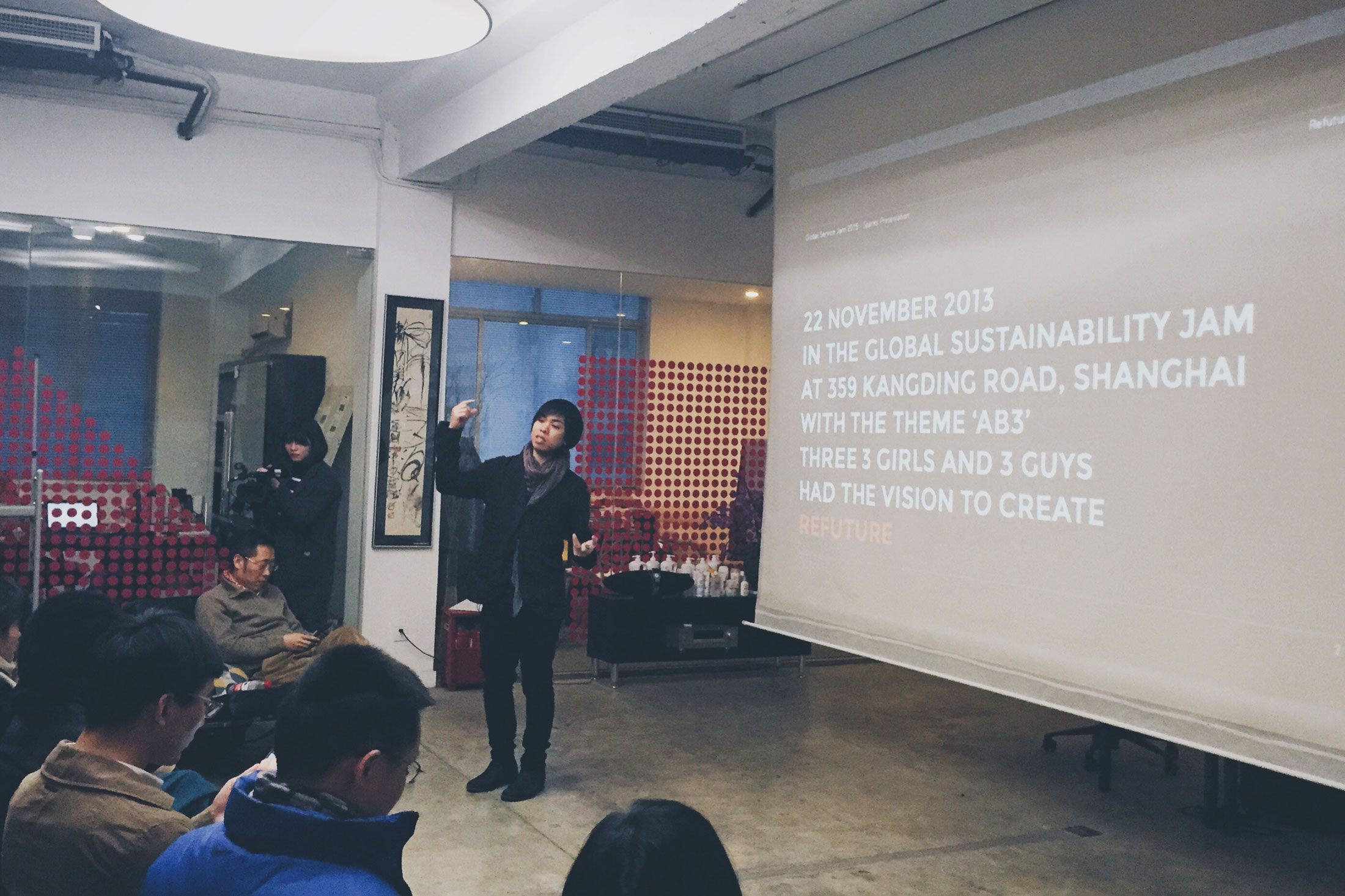This weekend, thousands of motivated designers and entrepreneurs in over 100 cities across the world took part in a special design event – the 2015 Global Service Jam. I was invited to be a speaker in Shanghai (or a ‘Spark’ as they call it) with the task to inspire participants to believe that what they create can really improve the lives of others. It was a great honour to be invited to speak as there’s nothing more worth spending your time on than inspiring others; so I thought long and hard about what advice I could give to really help. As people were mostly interested in how I work, I thought it’d be great to share the processes that were used to create Refuture – how to build solutions with limited resources and time.
Traditionally, most of the work processes we use are linear and operate in a step-by-step manner. This is great because it’s simple, reduces the margin for error, and is easy to coordinate with your team. A very typical process is:
- Research the problem
- Brainstorm for ideas
- Execute the solution
This is what we do in most of our corporate jobs, but it’s actually terrible for when you’re working in a dynamic and fast-paced environment because you often don’t have the necessary resources and need to cut corners to meet deadlines. These days as most environments are increasingly dynamic and fast-paced, it’s increasingly important to find new ways to work. With Refuture, we adopted a working methodology called Human-Centered Design, advocated by the innovation firm IDEO. Here’s how it’s different:
Traditional Work Process

 The above work process is what we’re all used to; we start in the first phase by researching the problem (discover), then we brainstorm for ideas (ideate), and then we execute on the chosen solution (prototype). As time goes on, we progress more and more towards completion. The Human-Centered Design (HCD) process on the other hand, has the same phases but it operates as a cycle towards completion rather than a sequential linear process. Allow me to illustrate:
The above work process is what we’re all used to; we start in the first phase by researching the problem (discover), then we brainstorm for ideas (ideate), and then we execute on the chosen solution (prototype). As time goes on, we progress more and more towards completion. The Human-Centered Design (HCD) process on the other hand, has the same phases but it operates as a cycle towards completion rather than a sequential linear process. Allow me to illustrate:
Human Centered Design Process

 The key difference in this work process is that you rapidly move between the three phases multiple times on the path to completion; discover > ideate > prototype > discover > ideate > prototype > discover > and so on. By spending shorter times in each phase, it is much faster to make a prototype into reality and therefore enables you to more quickly incorporate real world feedback into improving the original solution. In the traditional work process, it takes too long before any real testing of the solution occurs – so we spend a considerable amount of time on assumptions. I’m sure we’ve all encountered many situations where our original ideas were wrong and we’ve spent lots of time discussing the wrong problem and/or building the wrong solution. But in my humble opinion, the Human-Centered Design process excels above other processes in one key aspect: time.
The key difference in this work process is that you rapidly move between the three phases multiple times on the path to completion; discover > ideate > prototype > discover > ideate > prototype > discover > and so on. By spending shorter times in each phase, it is much faster to make a prototype into reality and therefore enables you to more quickly incorporate real world feedback into improving the original solution. In the traditional work process, it takes too long before any real testing of the solution occurs – so we spend a considerable amount of time on assumptions. I’m sure we’ve all encountered many situations where our original ideas were wrong and we’ve spent lots of time discussing the wrong problem and/or building the wrong solution. But in my humble opinion, the Human-Centered Design process excels above other processes in one key aspect: time.

 In fast-paced dynamic environments (tech, startups, consumer products, etc.), we’re often faced with very tight timeframes that can spontaneously change – and the last thing we want is to miss a window of opportunity. In the above illustration, the Human-Centered Design process would have went through 3 cycles of prototyping and feedback on the product before the traditional method has even started prototyping their solution. Essentially, the people using the traditional method would have been caught with their pants down.
In fast-paced dynamic environments (tech, startups, consumer products, etc.), we’re often faced with very tight timeframes that can spontaneously change – and the last thing we want is to miss a window of opportunity. In the above illustration, the Human-Centered Design process would have went through 3 cycles of prototyping and feedback on the product before the traditional method has even started prototyping their solution. Essentially, the people using the traditional method would have been caught with their pants down.
Using this style of working has enabled the Refuture team to move quickly, responsively, and stay constantly connected to real-user feedback. If you’re interested in learning more, you can take a free online course with great materials here at the +Acumen Human-Centered Design Course.
I hope this provides some insight to how we work at Refuture and hopefully inspires you to go out there and create something awesome. It’s really as easy as 1, 2, 3. Or should I say…1, 2, 3, 1, 2, 3, 1, 2, 3, 1…

